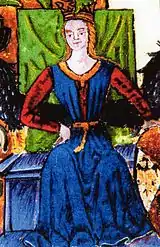Maria, Queen of Sicily
Maria (2 July 1363 – 25 May 1401) was Queen of Sicily and Duchess of Athens and Neopatria from 1377 until her death.
| Maria | |
|---|---|
 | |
| Queen of Sicily | |
| Reign | 27 July 1377 – 25 May 1401 |
| Coronation | 1377, Palermo |
| Predecessor | Frederick the Simple |
| Successor | Martin the Younger |
| Co-ruler | Martin the Younger |
| Born | 2 July 1363 Catania, Kingdom of Sicily |
| Died | 25 May 1401 (aged 37) Lentini, Kingdom of Sicily |
| Burial | |
| Spouse | Martin the Younger |
| Issue | Peter of Sicily |
| House | Aragón |
| Father | Frederick the Simple |
| Mother | Constance of Aragon |
Accession to the Sicilian Throne
Born in Catania, Maria was the daughter and heir of Frederick the Simple by his first wife Constance of Aragon. After her father's death in 1377, she ascended the Sicilian throne. Her government, however, was effectively taken over. She was only thirteen years old at the time, and the four baronial families who claimed her power styled themselves "vicars."
One of the Vicars, Artale Alagona, was previously named regent by Maria's father. In 1360—seventeen years before Queen Maria's ascension—Alagona had burnt and razed to the ground Augusta, an important fortified city, using forces from Syracuse and Catania.[1] However, Alagona's regency failed because of conflicts between the "Sicilian" and "Aragonese" parties, and he was forced to form a government with three other Vicars instead. The four baronial families were chosen to represent and equally distribute power between the Sicilian and Aragonese factions.
Unrest during the Vicars' Reign
The Kingdom of Sicily, briefly thereafter, was ruled by the following four Vicars: Artale Alagona, Francesco II, Manfredi III Chiaramonte, and Guglielmo Peralta.
including Francesco II count of Ventimiglia, Manfredi III Chiaramonte, count of Modica, and Guglielmo Peralta, count of Caltabellotta, a parity of exponents of the "Sicilian" and "Aragonese" parties. However, the four men ruled in their separate baronial lands alone. In 1379 she was kidnapped by count William Raymond of Montcada, Sicilian nobleman and member of the Aragonese House of Montcada, to prevent her marriage with Giangaleazzo Visconti, Duke of Milan, and imprisoned for two years at Licata. Montcada's move had been approved by her grandfather King Peter IV of Aragon. In 1382 Maria was rescued by an Aragonese fleet; she was taken first to Sardinia, then, in 1384, to Aragon, where she was married to Martin the Younger, the grandson of Peter IV (1390).
Co-reign with Martin the Younger
In 1392 Maria and Martin returned with a military force and defeated the opposing barons, ruling jointly until Maria's death in 1401. At that time, Martin repudiated the Treaty of Villeneuve (1372) and ruled Sicily alone. She also survived their only son, Peter (1398–1400). The kingdom remained without a crown prince and this caused a succession crisis for Martin, who ruled by right of his wife. Frederick the Simple had named his illegitimate son, William, Count of Malta, as heir presumptive in the case of the extinction of his daughter's line. William had died in c. 1380, but he had a daughter, Joan, wife of the Sicilian nobleman Pietro di Gioeni. She, however, cannot have contested her uncle's claim since Martin continued to rule unopposed until his death.
Maria of Sicily died at Lentini in 1401.
References
- Murray (Firm), John (1890). A Handbook for Travellers in Southern Italy and Sicily: Comprising the Description of Naples and Its Environs, Pompeii, Herculaneum, Vesuvius, Sorrento; the Islands of Capri, and Ischia; Amalfi, Pæstum, and Capua, the Abruzzi and Calabria; Palermo, Girgenti, the Greek Temples, and Messina. J. Murray.
- Lo Forte Scirpo, Maria Rita (2003). C'era una volta una regina...: due donne per un regno: Maria d'Aragona e Bianca di Navarra. Naples: Liguori. ISBN 88-207-3527-X.
- Di Blasi, Giovanni Evangelista (1847). Storia del regno di Sicilia (in Italian). Volume 3. Edizioni Dafni.
- Murray, John (1890). A Handbook for Travellers in Southern Italy and Sicily: Comprising the Description of Naples and Its Environs, Pompeii, Herculaneum, Vesuvius, Sorrento; the Islands of Capri, and Ischia; Amalfi, Pæstum, and Capua, the Abruzzi and Calabria; Palermo, Girgenti, the Greek Temples, and Messina. Volume 2.